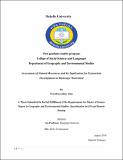| dc.description.abstract | Land use and land cover change has become a central component in current strategies for managing natural resources and monitoring environmental changes. To assess the natural resources and to maintain the potentials of the area, a land cover mapping was done. The aim of this study was to detect the extent and rate of land use and land cover change for the last 28 years. The landsat imageries of 1986, 2000, 2007 and 2014 were taken for land use and land cover classification. For the classification purposes, five land use and land cover classes were identified. Change Detection between the images for all the land use and land cover classes were computed. For Accuracy Assessment Classification error matrix was done. The floristic composition and structure of Hugumburda forest, is described and related to environmental factors. To analyze the forest and environmental data forty plots (10m x 10m) were used. For each species the abundance value was estimated. Height and diameter at breast height (DBH) of all woody individuals taller than 2 m and thicker than 2 cm were measured. A total of 41 species belonging to 32 families were recorded. The most extensive land cover category of the study area is farmland i.e. 46.8%. The second most extensive land cover category is forest 33.3% in 2014. The overall accuracy of classification methodology is 82.11% for the 2000 and 2007 images. Seven most abundant families were found namely: Fabaceae, Anacardiaceae, Apocynaceae, Celastraceae, Cupressaceae, Sapindaceae and Solanaceae. Regarding plant life forms, the forest is composed of 56 % shrub, 44 % tree species. Related to the bird species, a total of 66 species of birds grouped under 19 families were recorded. Family Alopochen aegyptiacus (20.07%) had the highest number of species. The lowest number of species was under the Families Phalacrocorax carbo (0.14%), Phoenicopterus minor (0.15%) and Lissotis melanogaster (0.15%) respectively. Lake Hashenge has two species of fish and grouped under two families. The analyses of the study revealed that natural resources such as abundance and diversity of bird, forest, fish, lake and beautiful landscape attractions at nearby areas are the main ecotourism potential in the study area. | en_GB |


